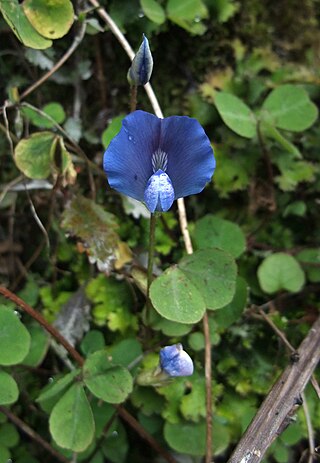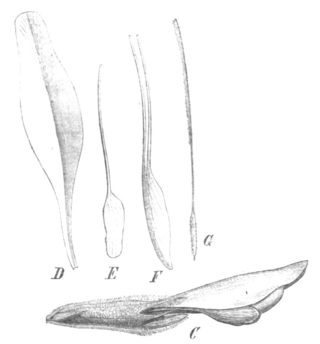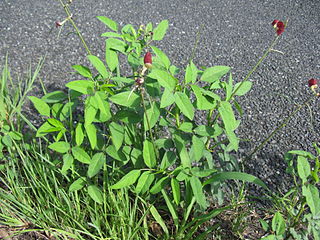
Afgekia is a small genus of large perennial climbing shrubs native to Thailand in Asia, belonging to the family Fabaceae. They are reminiscent of the related genus Wisteria.

Lathyrus japonicus, the sea pea, beach pea, circumpolar pea or sea vetchling, is a species of flowering plant in the legume family Fabaceae, native to temperate coastal areas of the Northern Hemisphere, and Argentina.

Parochetus communis, known in English as shamrock pea or blue oxalis, is a species of legume, and the only species in the genus Parochetus and in the subtribe Parochetinae. It is a low-growing plant with blue papilionaceous flowers and clover-like leaves. It is found in the mountains of Asia and tropical Africa, and has been introduced to New Zealand.

Barbieria is a genus of flowering plants in the legume family, Fabaceae. It contains a single species, Barbieria pinnata, a climber native to the tropical Americas, from southern Mexico through Central America and the Caribbean to northern South America.

Callerya is a genus of flowering plants in the legume family, Fabaceae. It belongs to the subfamily Faboideae, tribe Wisterieae. It includes 12 species native to the eastern Himalayas, Indochina, southern China and Taiwan, and Peninsular Malaysia. Its species are climbers, generally reaching up to about 1 m (3 ft) tall. The genus has a somewhat complicated taxonomic history; its circumscription was substantially revised in 2019.
Sarcodum is a genus of flowering plants in the legume family, Fabaceae. It belongs to the subfamily Faboideae, tribe Wisterieae. Its three species are twining vines growing over shrubs, and are native from southeast mainland China to the Solomon Islands.

Austrocallerya megasperma, one of several species commonly known as native wisteria, is a species of flowering plant in the family Fabaceae and is endemic to eastern Australia. It is a woody climber with pinnate leaves and racemes of purple, pea-like flowers.
Padbruggea is a genus of flowering plants in the family Fabaceae. Its native range stretches from southern China to western Malesia.

Whitfordiodendron is a genus of flowering plants in the legume family, of Fabaceae. It belongs to the subfamily Faboideae.
Otholobium accrescens is an upright, largely herbaceous subshrub assigned to the Pea family. It has up to three stems that carry upright branches in leaf axils near the ground, and have alternately set inverted egg-shaped leaves and lax heads consisting of 12-21 pea-like flowers on long peduncles in the axils of the lower leaves. It differs from most other Otholobium species by the calyx that continues to grow after flowering and the leaf that consists of just one leaflet. It is an endemic of the Eastern Cape province of South Africa near Loerie. It probably flowers August to January.

Wisteriopsis is a genus of flowering plants belonging to the family Fabaceae. Its native range is China to Indo-China and Temperate Eastern Asia. Wisteriopsis species are twining woody vines, generally resembling species of Wisteria. The genus was established in 2019 as a result of a molecular phylogenetic study, and includes species formerly placed in Millettia or Callerya.

Austrocallerya is a genus of flowering plants belonging to the subfamily Faboideae in the family Fabaceae. They are robust, twining woody vines.

Nanhaia is a genus of flowering plants belonging to the family Fabaceae. Its native range is Southern China to Northern Vietnam.

Macroptilium lathyroides is a species of plant in the legume family (Fabaceae) commonly known as the phasey bean. It is the type species of genus Macroptilium. Herbaceous annual or short-lived perennial growing up to 1 m high, it is native to the tropical and subtropical areas of Central and South America, and naturalized throughout the tropics. It is cultivated for forage or as a green manure or cover crop in rotation. As it quickly spreads on disturbed soils, it is considered an environmental weed in some areas.

Wisterieae is a tribe of flowering plants in the bean family Fabaceae. The tribe was first described in 1994 for the sole genus Wisteria, but was greatly expanded in 2019 to include 13 genera, six of which were new. Five had previously been placed in the tribe Millettieae. Members of the tribe are climbers of various kinds. Some, like Wisteria, are cultivated for their flowers.
Sigmoidala is a monotypic genus of flowering plants in the family Fabaceae, first established in 2019. Its only species is Sigmoidala kityana, native to Myanmar, northern Thailand and Laos. It was first described by William Grant Craib in 1927 as Millettia kityana.
Kanburia is a genus of flowering plant in the family Fabaceae, native to Thailand. The genus was established in 2019. Kanburia species are twining woody vines.
Serawaia is a monotypic genus of flowering plants in the family Fabaceae, first established in 2019. Its only species is Serawaia strobilifera, endemic to Borneo. The species was first described in 1994 as Callerya strobilifera.

Austrocallerya pilipes, synonym Callerya pilipes, is a species of flowering plant in the family Fabaceae, endemic to Queensland, Australia. It is a robust twining vine, climbing up trees and shrubs. It is known as the northern wistaria.

Austrocallerya australis, commonly known as native wisteria, blunt wisteria or Samson's sinew in Australia, is a species of flowering plant in the family Fabaceae, native to north-eastern Australia, New Guinea and some Pacific Islands. It is a tall, woody climber with pinnate leaves, the leaflets oblong, elliptic or egg-shaped, and panicles of purple, pea-like flowers.












